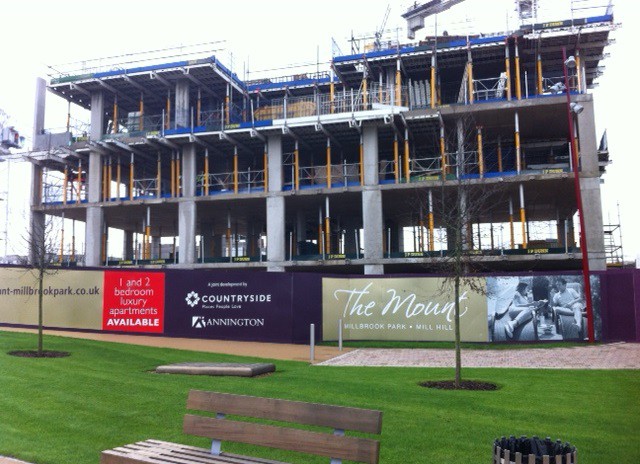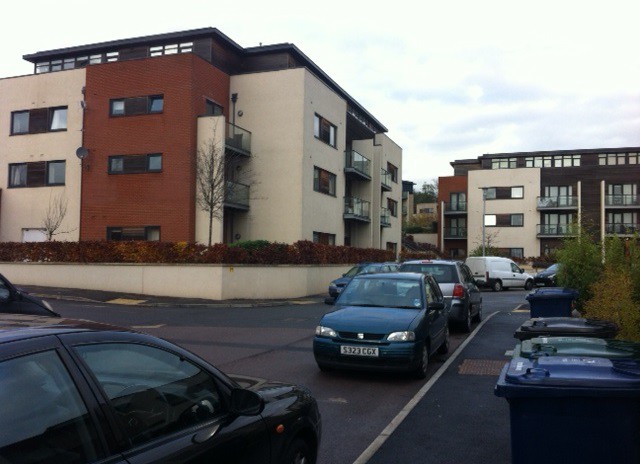
On the 27th of November, a team of researchers from LSE travelled to Millbrook Park in North Barnet to learn more about how barriers to development are being overcome at complex sites across London.
The development had been discussed at the 29th October workshop on accelerating new housing production in London as an example of a large site where innovative strategies like partnership working and strategic parcelling of sites was facilitating the much-needed development of new housing.
Like other complex sites with great development potential around London, multiple land owners presented an initial challenge to bringing the site forward. Most of the 83 acre site was originally owned by the Ministry of Defence and was home to the Inglis Barracks until 1997. After this point, various parcels were sold off to a private landlord, a social landlord and a developer, each with understandably different aspirations. According to the Keith Hurford, the Project Director for Millbrook Park, it was likely before the recession that the highly valuable land would have been sold off, further fragmenting the site and increasing the complexity of delivery. The outbreak of the Global Financial Crisis, however, caused the various parties to consider the benefits of combining the separate parcels and developing the land together. Without a joint approach the three parties risked going their separate ways. This is likely to have resulted in the land owners not maximising any capital receipt. In 2010, the landowners looked at the long-term financial and qualitative benefits of a collaborative approach. Combining sites and expertise through the Co-operation Agreement of each of the three principal parties could achieve a potential “regeneration uplift” as well as better coordination and viability on infrastructure investment and delivery.
Consequently, the Inglis Consortium was formed; a coalition of the 3 landowners who agreed to split the proceeds of the future development (all of which is to be sold ‘freehold’) based on proportional share of land ownership.
The Consortium parcelled the site into 16 phases. As of 2014, phases 1-3 have been sold to house builders and construction is well underway on further phases. In all, the development will include:
- 2,174 new homes
- A new three-form entry primary school (completed)
- New parks and open spaces
- New office space
- Conversion of Listed former Officer’s Barracks into 10 apartments (completed)
Millbrook Park reveals numerous lessons that could inform strategies and ideas for increasing the development of new housing supply across the capital:

Adverse conditions can spur beneficial innovation. The external shock of the financial crisis and subsequent recession was, according to the project director, one of the factors which lead to formation of the strategic partnership at the site. In times of economic stress and uncertainty, then, it stands that innovative ‘breaks from the norm’ can produce arrangements that continue to be beneficial even when economic conditions improve. These benefits, in the case of Millbrook Park, include strong working relationships between partners and the borough and committed leadership overseeing the project as a whole all of which is centred on a shared strategic vision of the site.
A sense of shared vision is vital for partnership functioning. Members of the Inglis Consortium argue that the benefits of a single, united body having overarching control of the development are numerous. Together, upfront funds for costly processes like remediation and road construction are more easily secured. Additionally, members of the Consortium argue that developers are rarely motivated individually to ensure design consistency or to invest in or maintain roads, green spaces and public realm. The partnership, therefore, allows for greater control over:
- Design
- Management of communal spaces and important shared infrastructure
- Marketing and branding of the development
- Speed at which parcels are developed

Viability concerns may be alleviated by parcelling the land in smaller segments. A major barrier widely discussed at the 29th October workshop was the long, increasingly technical and difficult process of viability negotiation that local authorities and developers must engage in. The team behind Millbrook Park argue that parcelling land into smaller segments reduces risk and may alleviate concerns about viability, speeding up eventual development on the site.
Smaller sites but in different places? Nevertheless, concerns still remain that on big sites, the build-out rate has to be slow to ensure sufficient cost price ratios. Consequently, while dividing a site into smaller parcels may alleviate some of the burdens related to viability negotiations, it can still result in a very slow production of new housing. Slow development may be better than no development, but interviewees did suggest that perhaps the solution is many smaller sites in many different locations rather than focusing development on large sites like this case study.
Challenges remain—particularly difficulties facing the house building industry. Finally, discussions at the site visit revealed

that part of the reason housing development is proceeding very slowly in the UK lies with the house building industry and specifically the skills and materials shortages that can slow up construction. This element certainly warrants more research and exploration and links questions of housing supply to other related subjects such as labour market transformations and migration.
For more information on this site visit or if you have a site that you think illustrates the complexities and opportunities for accelerating residential development in London, please contact Dr. Nancy Holman at N.E.Holman@lse.ac.uk.




